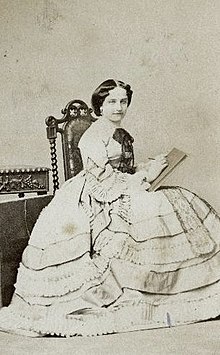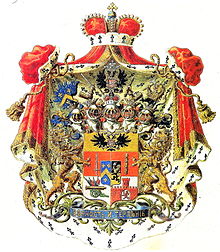Alexander Barclay de Tolly-Weymarn
This article includes a list of general references, but it lacks sufficient corresponding inline citations. (September 2017) |
Prince Alexander Magnus Friedrich Barclay de Tolly-Weymarn (Russian: Александр Петрович Барклай-де-Толли-Веймарн, Alexander Petrovich Barklay-de-Tolli-Veymarn; December 22, 1824 – May 8, 1905), born as Alexander Magnus Friedrich von Weymarn, was a Baltic German military commander who served in the Imperial Russian Army.
Alexander Barclay de Tolly-Weymarn | |
|---|---|
 | |
| Birth name | Alexander Magnus Friedrich von Weymarn |
| Born | December 22, 1824 Pärnu, Governorate of Livonia, Russian Empire |
| Died | May 8, 1905 Dresden, Kingdom of Saxony, German Empire |
| Allegiance | |
| Service | |
| Commands | Pavlovsky Regiment 24th Infantry Division 1st Army Corps |
| Battles / wars | Russo-Turkish War |


Life and family
editHe was a member of the Baltic German nobility, and the son of General Wilhelm Peter Jost von Weymarn (1793–1846) and his wife, Christina Augusta von Lueder (1803–1887). He married Marie Friederike von Seddeler in 1849 and had three children: daughters Alexandrine "Ada" Auguste Olga Barclay de Tolly-Weymarn and Marie "Mira" Georgia Augusta Barclay de Tolly-Weymarn, and son Ludwig Alexander Michael Barclay de Tolly-Weymarn.
His maternal grandmother was the sister of Prince Michael Andreas Barclay de Tolly, a very prominent military commander who was made a count in 1813 and a prince in 1815 by Alexander I of Russia. After the extinction of the original Barclay de Tolly princely line upon the death in 1871 of Prince Michael's son (Magnus Barclay de Tolly), Alexander von Weymarn was allowed to assume the title of Prince Barclay de Tolly-Weymarn in 1872, by permission of Alexander II of Russia.[1]
Honours
editRussian orders and decorations
edit- Knight of the Imperial Order of Saint Anna, 3rd Class, 1849; 2nd Class, 1855; 1st Class, 1864
- Knight of the Imperial Order of Saint Vladimir, 4th Class, 1856; 3rd Class, 1860; 2nd Class, 1869
- Knight of the Imperial Order of Saint Stanislaus, 1st Class, 1861
- Knight of the Imperial Order of the White Eagle
- Knight of the Imperial Order of Saint Alexander Nevsky, 1886
Foreign orders and decorations
edit- House and Merit Order of Peter Frederick Louis, 3rd Class
- Grand Cross of the Order of the Dannebrog, 13 December 1867[2]
- Knight of the Order of the Red Eagle, 1st Class, 7 May 1873[3]
- Knight of the Order of the Iron Crown, 1st Class, 1874
- Commander Grand Cross of the Royal Order of the Sword, 19 July 1875[4]
- Grand Cross of the House Order of the Wendish Crown, with Golden Crown, 16 February 1876[5]
References
edit- ^ "Genealogisches Handbuch der Oeselschen Ritterschaft, Seite 442".
- ^ Bille-Hansen, A. C.; Holck, Harald, eds. (1903) [1st pub.:1801]. Statshaandbog for Kongeriget Danmark for Aaret 1903 [State Manual of the Kingdom of Denmark for the Year 1903] (PDF). Kongelig Dansk Hof- og Statskalender (in Danish). Copenhagen: J.H. Schultz A.-S. Universitetsbogtrykkeri. pp. 17–18. Retrieved 10 February 2021 – via da:DIS Danmark.
- ^ Königlich Preussische Ordensliste (in German), vol. 1, Berlin: Gedruckt in der Reichsdruckerei, 1886, p. 36 – via hathitrust.org
- ^ Sveriges statskalender (PDF) (in Swedish), Stockholm, 1894, p. 400 – via gupea.ub.gu.se
{{citation}}: CS1 maint: location missing publisher (link) - ^ "Großherzogliche Orden und Ehrenzeichen". Hof- und Staatshandbuch des Großherzogtums Mecklenburg-Strelitz: 1878 (in German). Neustrelitz: Druck und Debit der Buchdruckerei von G. F. Spalding und Sohn. 1878. p. 12.
Bibliography
edit- Baltische Historische Kommission (Hrsg.): Weymarn, Alexander Magnus Friedrich v., seit 31. Mai 1872 Fürst Barclay de Tolly-W. In: BBLd – Baltisches Biographisches Lexikon digital. Göttingen 2012.
- Nicolai von Essen (Hrsg.): Genealogisches Handbuch der Oeselschen Ritterschaft. Tartu, 1935, S. 443.
- Genealogisches Handbuch der Baltischen Ritterschaften. (Neue Folge), Band 2, Hamburg 2012, S. 28–31.
- Genealogisches Handbuch der baltischen Ritterschaften. Teil 2, 3: Estland. Görlitz 1930, S. 274f.